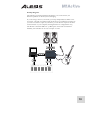
8
About the Acoustic Space Switch
The bass response of a speaker is greatly affected by the
speaker’s proximity to walls. You’ll notice a buildup in
bass frequencies as a speaker moves closer to a wall and
even more buildup as the speaker moves closer to a
corner. This happens because low frequencies radiate in
all directions from the speaker cabinet and are reflected
off your walls back into your control room. When this
happens, the reflected sound mixes with the direct
sound of the speaker itself resulting in “reinforced” bass.
We know that most home and project studios are set up under less than ideal
conditions, so we’ve added the Acoustic Space Switch to help you optimize your
speakers to your room.
If your speakers are farther than about 3 feet away from the walls of your studio,
leave this switch set to the default “0” setting. This “full space” setting outputs
bass normally.
If the speaker is up against a wall, set the Acoustic Space Switch to “2.” This
setting is known as “half-space” and compensates for boosted bass due to your
speakers being placed near one wall.
Finally, if your speaker is positioned in a corner, set this switch to “4.” This is
known as a “quarter-space” setting and compensates for placement next to two
walls.
Unlike bass frequencies, midrange
and high frequency sounds are
much more “directional” and only
radiate forward. Because of this,
the Acoustic Space Switch only
deals with bass frequencies—there
is no need for high frequency
com
p
ensation near walls.


















